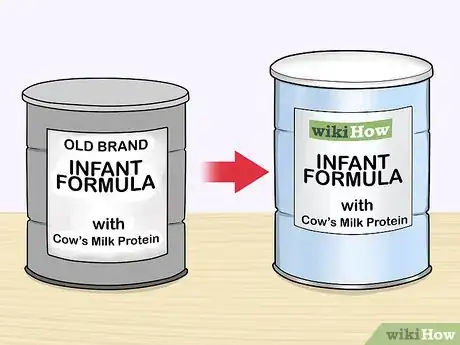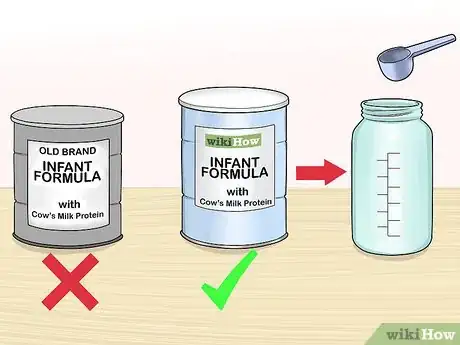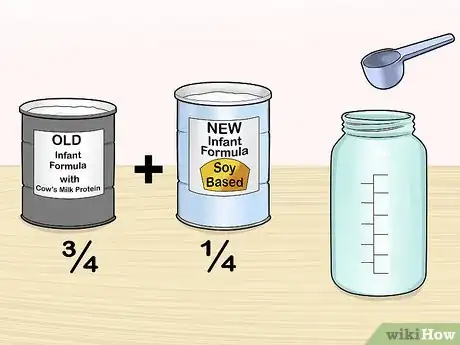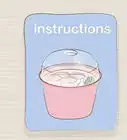This article was co-authored by Sarah Siebold, IBCLC, MA. Sarah Siebold is an International board certified Lactation Consultant (IBCLC) and Certified Lactation Educator Counselor (CLEC) based in Los Angeles, California. She runs her own lactation consulting practice called IMMA, where she specializes in emotional support, clinical care, and evidence-based breastfeeding practices. Her editorial work about new motherhood and breastfeeding has been featured in VoyageLA, The Tot, and Hello My Tribe. She completed her clinical lactation training in both private practice and outpatient settings through the University of California, San Diego. She also earned her M.A. in English and American Literature from New York University.
This article has been viewed 444,864 times.
You may need to switch your baby's formula for cost reasons, or because you're hoping to make your baby's tummy feel better. It's important to talk to your doctor before you make the change. Infant formulas are highly regulated and they all must provide adequate and complete nutrition for infants. As a result, switching baby formulas can be done quite easily. Simply select a new formula, gradually transition between formulas, and then monitor your baby to ensure they don’t have a reaction to the new formula.
Steps
Selecting a New Infant Formula
-
1Consult a doctor or pediatrician before switching formulas. You should always talk with your doctor before switching formulas. This includes if you are switching for dietary or financial reasons. Your doctor will be able to recommend a formula suitable for your baby and can help you with the transition to a new formula.[1]
- If your baby gets hives, a rash, redness, or vomits forcefully after drinking formula, they may have a true allergy to the milk or soy protein found within the formula.
- Your doctor or pediatrician may also recommend switching formulas for dietary reasons or due to poor weight gain. For example, your baby may need more iron in their diet and, therefore, an iron-fortified formula may be best. Certain formulas may also be recommended for babies with severe acid reflux.
- If the doctor does not suspect a true medical problem; however, they may be able to recommend a brand or formula that can improve other health symptoms, such as fussiness, gas, and difficulty pooping.
-
2Consider a new formula with the same protein type. It will be easiest on your baby’s digestive system to stick with the same protein type when switching formulas. If you have decided to try a new brand for cost rather than medical reasons, this should be relatively easy. For example, if your baby's current formula uses cows' milk as the protein type, then you should choose a new less expensive formula that also uses a similar ratio of cows' milk. If the protein in the initial formula was hydrolyzed or partially hydrolyzed, keep this consistent in the new formula. [2]Advertisement
-
3Choose a formula with a different protein for digestive intolerances. If you are switching formulas because your baby has a digestive intolerance, you will need to choose a formula with a different protein type. See which new formula your doctor thinks will help your baby's digestion.[3]
- Your doctor may recommend that you try a soy-based formula instead of a cows' milk formula to treat a casein intolerance.
-
4Read the formula labels. If your baby was previously drinking a formula with iron, DHA, or other additives, consider selecting another formula with those characteristics. Reading the label will also help you understand the ingredients and you can avoid any ingredients that may cause an allergic reaction in your baby.
Changing over to the New Formula
-
1Switch formula immediately if you are using the same protein. In some instances, your baby will be able to switch formulas relatively easily and will not fuss about a new type of formula. Try giving your baby a little bit of the new formula to see how they react. If there is no issue, then you can switch to the new formula immediately.[4]
- If the baby fusses after trying the new formula, wait a few minutes and try again. Don't offer the baby any alternatives, and don't give them the old formula again.
- Similarly, if your baby is allergic to their old formula, you may need to switch completely to the new formula with no period of transition.
-
2Transition gradually to a new formula if you are changing the main protein. In some cases, your baby may be a little fussy about the taste of the new formula. In these instances, switch formulas gradually. This will mask the flavour of the new formula and make the transition easier.[5]
- Begin the transition by giving your baby ¾ of the old formula and ¼ of the new formula.
- Feed your baby this mixture for one day. Then, try half of the old formula with half of the new formula and feed your baby this mixture for one day.
EXPERT TIPSarah Siebold is an International board certified Lactation Consultant (IBCLC) and Certified Lactation Educator Counselor (CLEC) based in Los Angeles, California. She runs her own lactation consulting practice called IMMA, where she specializes in emotional support, clinical care, and evidence-based breastfeeding practices. Her editorial work about new motherhood and breastfeeding has been featured in VoyageLA, The Tot, and Hello My Tribe. She completed her clinical lactation training in both private practice and outpatient settings through the University of California, San Diego. She also earned her M.A. in English and American Literature from New York University.International Board Certified Lactation Consultant
 Sarah Siebold, IBCLC, MA
Sarah Siebold, IBCLC, MA
International Board Certified Lactation ConsultantDid You Know? The nutritional makeup of breastmilk changes over time to fit your baby's needs. Because formula doesn't, the amount of formula your baby needs may be different than their breastmilk needs. After about 2 weeks of age, babies who are taking a bottle of breast milk only need about 3 oz at a time, even as they grow. With formula, on the other hand, you have to increase the volume over time in order for babies to gain weight appropriately.
-
3Increase the ration of new formula to old formula. Continue to increase the ratio of new formula to old formula each day. For example, on the third day feed your baby a mixture of ¼ of the old formula with ¾ of the new formula and on the fourth day give your baby 100% of the new formula.[6]
- By this point your baby should expect the flavour of the new formula.
Monitoring Your Baby’s Reaction to the Formula
-
1Weigh the baby periodically. Make sure that they're reaching a healthy weight on the new formula. Either use a scale at home or take the baby to the doctor. It is normal for most babies to double their birth weight by 5 months, but you should talk to your doctor about what is a healthy development for your baby.[7]
-
2Watch for digestive problems. While transitioning from one formula to another, monitor your baby. Watch for persistent vomiting, diarrhea, excessive gas, or constipation. These are all signs that your baby may be experiencing an allergic reaction. Allergic reactions differ from normal digestive irritation because they are chronic and may impact your baby's ability to gain weight.[8]
- For instance, acute diarrhea and gas is common among babies, but chronic diarrhea or constipation often means the child has an intolerance.[9]
- If you believe your baby has an allergy to the new formula, seek medical attention immediately.
-
3Notice hives or a rash. Allergies can also present themselves on the surface of the skin in the form of hives or rashes. If you baby begins to develop a rash, you should take them to a doctor immediately. This could be a sign that they are allergic to the new formula.[10]
-
4Look for blood in your baby’s stool or vomit. If you notice blood in your baby’s stool or vomit, you should take your baby to the emergency room immediately. This is a sign of a severe allergic reaction and needs medical treatment.[11]
Expert Q&A
Did you know you can get expert answers for this article?
Unlock expert answers by supporting wikiHow
-
QuestionCan you feed a baby formula and breastfeed at the same time?
 Rebecca Nguyen, MARebecca Nguyen is a Certified Lactation Consultant and Childbirth Educator. She runs Family Picnic in Chicago, Illinois with her mother Sue Gottschall, where they teach new parents about childbirth, breastfeeding and child development and education. Rebecca taught preschool through 3rd grade for 10 years, and she received her Master’s Degree in Early Childhood Education from the University of Illinois in 2003.
Rebecca Nguyen, MARebecca Nguyen is a Certified Lactation Consultant and Childbirth Educator. She runs Family Picnic in Chicago, Illinois with her mother Sue Gottschall, where they teach new parents about childbirth, breastfeeding and child development and education. Rebecca taught preschool through 3rd grade for 10 years, and she received her Master’s Degree in Early Childhood Education from the University of Illinois in 2003.
International Board Certified Lactation Consultant
-
QuestionHow do I know if the formula I am using is the right formula for my baby?
 Catherine Palomino, MSCatherine Palomino is a former Childcare Center Director in New York. She received her MS in Elementary Education from CUNY Brooklyn College in 2010.
Catherine Palomino, MSCatherine Palomino is a former Childcare Center Director in New York. She received her MS in Elementary Education from CUNY Brooklyn College in 2010.
Master's Degree, Elementary Education, CUNY Brooklyn College
-
QuestionDoes this work for very young babies?
 Catherine Palomino, MSCatherine Palomino is a former Childcare Center Director in New York. She received her MS in Elementary Education from CUNY Brooklyn College in 2010.
Catherine Palomino, MSCatherine Palomino is a former Childcare Center Director in New York. She received her MS in Elementary Education from CUNY Brooklyn College in 2010.
Master's Degree, Elementary Education, CUNY Brooklyn College
Warnings
- Don’t switch formulas multiple times, unless directed by your doctor or pediatrician. Switching formula often can be hard on your baby’s digestive system.⧼thumbs_response⧽
- If your baby has been diagnosed with a metabolic disorder, milk protein allergy, or failure to thrive, always consult a pediatrician before changing infant formulas.⧼thumbs_response⧽
References
- ↑ http://www.newkidscenter.com/Switching-Baby-Formula.html
- ↑ https://www.babycenter.com/404_can-i-switch-formula-brands-and-if-so-how-do-i-ease-the-tran_1334521.bc
- ↑ https://www.babycenter.com/404_can-i-switch-formula-brands-and-if-so-how-do-i-ease-the-tran_1334521.bc
- ↑ http://www.newkidscenter.com/Switching-Baby-Formula.html
- ↑ http://www.newkidscenter.com/Switching-Baby-Formula.html
- ↑ http://www.newkidscenter.com/Switching-Baby-Formula.html
- ↑ https://www.mayoclinic.org/healthy-lifestyle/infant-and-toddler-health/expert-answers/infant-growth/faq-20058037
- ↑ http://kidshealth.org/en/parents/formulafeed-concerns.html#
- ↑ http://www.babycareadvice.com/article/detail/What_Causes_Baby_Diarrhea
About This Article
Before switching baby formulas, talk to your baby’s doctor to get their recommendations. Your doctor may recommend a transition plan such as mixing 1/4 of the new formula with 3/4 of the old formula on the first day. The next day, prepare the bottle with 1/2 of the new formula and 1/2 the old formula. Then, gradually increase the ratio of the new formula to the old formula each day. If your baby has digestive problems or develops a rash during the transition, see your doctor right away since your child might have an allergy to the formula. For tips from our Childcare reviewer on how to pick a new formula for your baby, read on!






























































